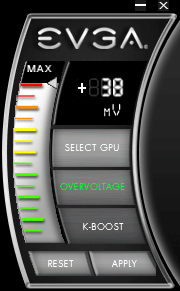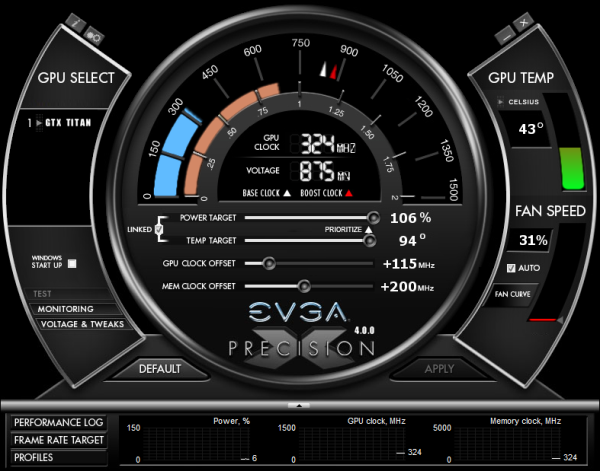NVIDIA’s GeForce GTX Titan Review, Part 2: Titan's Performance Unveiled
by Ryan Smith & Rahul Garg on February 21, 2013 9:00 AM ESTThe Final Word On Overclocking
Before we jump into our performance breakdown, I wanted to take a few minutes to write a bit of a feature follow-up to our overclocking coverage from Tuesday. Since we couldn’t reveal performance numbers at the time – and quite honestly we hadn’t even finished evaluating Titan – we couldn’t give you the complete story on Titan. So some clarification is in order.
On Tuesday we discussed how Titan reintroduces overvolting for NVIDIA products, but now with additional details from NVIDIA along with our own performance data we have the complete picture, and overclockers will want to pay close attention. NVIDIA may be reintroducing overvolting, but it may not be quite what many of us were first thinking.
First and foremost, Titan still has a hard TDP limit, just like GTX 680 cards. Titan cannot and will not cross this limit, as it’s built into the firmware of the card and essentially enforced by NVIDIA through their agreements with their partners. This TDP limit is 106% of Titan’s base TDP of 250W, or 265W. No matter what you throw at Titan or how you cool it, it will not let itself pull more than 265W sustained.
Compared to the GTX 680 this is both good news and bad news. The good news is that with NVIDIA having done away with the pesky concept of target power versus TDP, the entire process is much simpler; the power target will tell you exactly what the card will pull up to on a percentage basis, with no need to know about their separate power targets or their importance. Furthermore with the ability to focus just on just TDP, NVIDIA didn’t set their power limits on Titan nearly as conservatively as they did on GTX 680.
The bad news is that while GTX 680 shipped with a max power target of 132%, Titan is again only 106%. Once you do hit that TDP limit you only have 6% (15W) more to go, and that’s it. Titan essentially has more headroom out of the box, but it will have less headroom for making adjustments. So hardcore overclockers dreaming of slamming 400W through Titan will come away disappointed, though it goes without saying that Titan’s power delivery system was never designed for that in the first place. All indications are that NVIDIA built Titan’s power delivery system for around 265W, and that’s exactly what buyers will get.
Second, let’s talk about overvolting. What we didn’t realize on Tuesday but realize now is that overvolting as implemented in Titan is not overvolting in the traditional sense, and practically speaking I doubt too many hardcore overclockers will even recognize it as overvolting. What we mean by this is that overvolting was not implemented as a direct control system as it was on past generation cards, or even the NVIDIA-nixed cards like the MSI Lightning or EVGA Classified.
Overvolting is instead a set of two additional turbo clock bins, above and beyond Titan’s default top bin. On our sample the top bin is 1.1625v, which corresponds to a 992MHz core clock. Overvolting Titan to 1.2 means unlocking two more bins: 1006MHz @ 1.175v, and 1019MHz @ 1.2v. Or put another way, overvolting on Titan involves unlocking only another 27MHz in performance.

These two bins are in the strictest sense overvolting – NVIDIA doesn’t believe voltages over 1.1625v on Titan will meet their longevity standards, so using them is still very much going to reduce the lifespan of a Titan card – but it’s probably not the kind of direct control overvolting hardcore overclockers were expecting. The end result is that with Titan there’s simply no option to slap on another 0.05v – 0.1v in order to squeak out another 100MHz or so. You can trade longevity for the potential to get another 27MHz, but that’s it.
Ultimately, this means that overvolting as implemented on Titan cannot be used to improve the clockspeeds attainable through the use of the offset clock functionality NVIDIA provides. In the case of our sample it peters out after +115MHz offset without overvolting, and it peters out after +115MHz offset with overvolting. The only difference is that we gain access to a further 27MHz when we have the thermal and power headroom available to hit the necessary bins.
| GeForce GTX Titan Clockspeed Bins | |||
| Clockspeed | Voltage | ||
| 1019MHz | 1.2v | ||
| 1006MHz | 1.175v | ||
| 992MHz | 1.1625v | ||
| 979MHz | 1.15v | ||
| 966MHz | 1.137v | ||
| 953MHz | 1.125v | ||
| 940MHz | 1.112v | ||
| 927MHz | 1.1v | ||
| 914MHz | 1.087v | ||
| 901MHz | 1.075v | ||
| 888MHz | 1.062v | ||
| 875MHz | 1.05v | ||
| 862MHz | 1.037v | ||
| 849MHz | 1.025v | ||
| 836MHz | 1.012v | ||
Finally, as with the GTX 680 and GTX 690, NVIDIA will be keeping tight control over what Asus, EVGA, and their other partners release. Those partners will have the option to release Titan cards with factory overclocks and Titan cards with different coolers (i.e. water blocks), but they won’t be able to expose direct voltage control or ship parts with higher voltages. Nor for that matter will they be able to create Titan cards with significantly different designs (i.e. more VRM phases); every Titan card will be a variant on the reference design.
This is essentially no different than how the GTX 690 was handled, but I think it’s something that’s important to note before anyone with dreams of big overclocks throws down $999 on a Titan card. To be clear, GPU Boost 2.0 is a significant improvement in the entire power/thermal management process compared to GPU Boost 1.0, and this kind of control means that no one needs to be concerned with blowing up their video card (accidentally or otherwise), but it’s a system that comes with gains and losses. So overclockers will want to pay close attention to what they’re getting into with GPU Boost 2.0 and Titan, and what they can and cannot do with the card.











337 Comments
View All Comments
CeriseCogburn - Saturday, February 23, 2013 - link
Stop whining along with the rest of them, grow a set, get a job, and buy two of them.Might do you some good.
Alucard291 - Sunday, February 24, 2013 - link
Unlike you, I have a job :)chizow - Sunday, February 24, 2013 - link
Good point, I'd tend to agree with that assessment as anyone who actually works for their money would not be so eager to part with it so quickly in $1K denominations for what amounts to a glorified pinball machine.He's probably a kid who has never had to work a day in his life or a basement dweller who has no hope of ever buying one of these anyways.
CeriseCogburn - Sunday, February 24, 2013 - link
And now with the pure troll, the lying idiot conspiracist nVidia hater takes on the pure personal attack for a big fat ZERO score.Congratulations, you and your pure troll can high five each other and both be wrong anyway, for another yer or two, or the rest of your whining crybaby posting PC herd idiot mentality lives.
Alucard291 - Friday, March 8, 2013 - link
No no kid. You're the "pure troll here"So yeah go get a job and buy two of them. For yourself. Stop being angry at us for not being able to afford it
~lol~
wiyosaya - Thursday, February 21, 2013 - link
While I understand your frustrations, IMHO, this is a card aimed at those wanting the compute performance of a Tesla at 1/3 the cost. As I see it, nVidia shot themselves in the foot for compute performance with the 680, and as such, I bet that 680 sales were less than expected primarily because of its crappy compute performance in comparison to say even a 580. This may have been their strategy, though, as they might have expected $3,500 Teslas to fly off the shelf.I am also willing to bet that Teslas did not fly off the shelf, and that in order to maintain good sales, they have basically dropped the price of the first GK110s to something that is reasonable with this card. Once can now buy 3.5 Titan's for the price of the entry level GK110 Tesla, and I highly expect nVidia to make a profit rather than the killing that they might have thought possible on the GK110 Teslas.
That said, I bet that nVidia gets a sht load of orders for this card from new HPC builders and serious CAD/CAE workstation suppliers. Many CAD/CAE software packages like SolidWorks and Maple support GPGPUs in their code making this card a bargain for their builds.
My apologies, to all the gamers here but us compute nerds are drooling over this card. I only wish I could afford one to put in my i7-3820 build from July. It is more than 2x what I paid for a 580 back then, and the 580 buy was for its compute performance.
atlr - Thursday, February 21, 2013 - link
wiyosaya, I am trying to come up to speed on comparing compute performance between Nvidia and AMD options. Is the Titan drool-worthy only for software that only uses CUDA and not OpenCL? This reminds me of the days of Glide versus OpenGL APIs.trajan2448 - Friday, February 22, 2013 - link
AMDs fps numbers are overstated. They figured out a trick to make runt frames, or frames which are not actually rendered to trigger the fps monitor as a real fully rendered frame. This is real problem for AMD much worse than the latency problem. Crossfire is a disaster which is why numerous reviewers including Tech Report have written that Crossfire produces higher fps but feels less smooth than Nvidia.Check this article out. http://www.pcper.com/reviews/Graphics-Cards/NVIDIA...
chizow - Saturday, February 23, 2013 - link
That's an awesome analysis by PCPer, thanks for linking that. Might end up being the biggest driver cheat scandal in history. Runt framesgate lol.CeriseCogburn - Saturday, February 23, 2013 - link
HUGE amd cheat.It's their standard operating procedure.
The fanboys will tape their mouths, gouge out their eyes and stick fingers in their ears and chant: "I'm not listening".